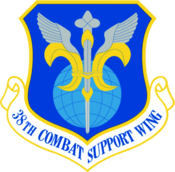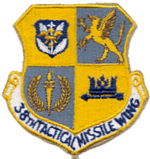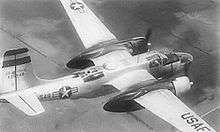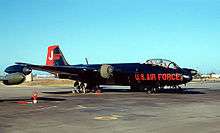38th Combat Support Wing
| 38th Combat Support Wing | |
|---|---|
|
Royal Air Force cadets training with the wing's 38th Construction & Training Squadron | |
| Active | 1948–1949; 1953-1966; 1973-1975; 1985-1990; 1994-2000; 2004-2007 |
| Country |
|
| Branch |
|
| Role | Central support of dispersed units |
| Part of | United States Air Forces Europe |
| Decorations | Air Force Outstanding Unit Award |
| Insignia | |
| 38th Combat Support Wing emblem |
 |

The 38th Combat Support Wing (38 CSW) is an inactive wing of the United States Air Force. Its last assignment was with Third Air Force, being inactivated on 1 May 2007 at Ramstein Air Base, Germany. The mission of the 38 CSW was to enhance support to USAFE geographically separated units.
The Wing's origins date to 1948 as the 38th Bombardment Wing. Its operational group, the 38th Bombardment Group, was one of the first Army Air Forces units to be deployed into the Pacific Theater after Pearl Harbor. The 38th CSW was temporarily authorized to display the honors earned by the group prior to 14 August 1948.[1]
History
- For additional history and lineage, see 38th Bombardment Group

The unit was established as 38th Bombardment Wing, Light on 10 August 1948 in Japan. It assisted in the air defense of Japan and participated in tactical exercises, August 1948 – March 1949. It was inactivated in the Far East on 1 April 1949.
The 38th Bombardment Wing was reactivated as part of the United States Air Forces in Europe on 1 January 1953, being assigned to Laon-Couvron Air Base, France. Upon activation, the wing absorbed the assets of the Air National Guard 126th Bomb Wing, which was inactivated and returned to the control of the Illinois Air National Guard. The 38th's squadrons were designated the 71st, 405th, and 822nd Bomb Squadrons. The wing flew the Douglas Douglas B-26 Invader until 1955.

The wing received its first Martin B-57B Canberra in June 1955, and began to replace its aging Douglas B-26 Invaders.[3] With the B-57's arrival, the B-26s were returned to CONUS. Because English Electric was unable to meet the USAF delivery schedule, the design was licensed to Martin for US manufacture. A total of 49 B-57B and 8 2-seat B-57C models were deployed to Laon.
The mission of the B-57 was to provide a nuclear deterrent for NATO and to deliver nuclear weapons against pre-selected targets, day or night. The aircraft at Laon were painted a gloss black. An acrobatic team was organized and named the Black Knights using five B-57s. The Black Knights performed at several air shows around Western Europe, including the 1957 Paris Air Show. The Black Knights were the only tactical bomber show team in the world.
In 1958, General De Gaulle announced that all nuclear weapons and delivery aircraft had to be removed from French soil by July 1958. Since NATO strategy had evolved into "massive nuclear retaliation" this meant all tactical fighter and bombing wings had to depart France.
The 38th TBW was inactivated at Laon on 18 June 1958 and redesignated as the 38th Tactical Missile Wing at Hahn Air Base West Germany, operating and maintaining first the TM-67A "Matador" and later the TM-76A Mace cruise missiles. The wing was inactivated in September 1966.
Air Training Command
The 38th was reactivated as the 38th Flying Training Wing and replaced the 3640th Pilot Training Wing at Laredo Air Force Base, Texas, on 1 August 1972. Its operational squadrons were the 40th and 41st Pilot Training Squadrons. The wing performed pilot training until 28 August 1973 when Laredo was inactivated.
The 38th Flying Training Wing was reassigned to Moody Air Force Base, Georgia on 1 December 1973, replacing the 3550th Pilot Training Wing. The 38th performed pilot training until 21 November 1975. On 1 December 1975 the 347th Tactical Fighter Wing, a unit of Tactical Air Command (TAC), relocated to Moody from Korat Royal Thai Air Force Base, Thailand and the mission of the base changed from pilot training under ATC to an active tactical fighter base under TAC.
The 38th FTW was inactivated on 1 December 1975.
Ground Launched Cruise Missiles
In April 1985, the 38th Tactical Missile Wing, was activated at Wüschheim Air Station, West Germany. The wing was assigned to tactical missile operations, equipped with Ground-Launched Cruise Missiles (GLCM) to counter Soviet intermediate-range ballistic missiles from 1986–1990. The GLCMs (and their strategic cousins, the Pershing IIs) were deployed, in part, to balance/counter the deployment of the Soviet RSD-10 'Pioner' (SS-20) IRBM.
It was this realization that led to the opening of the Intermediate-range Nuclear Forces (INF) talks and an INF treaty that eventually removed an entire class of nuclear arms from the superpower arsenals. The Intermediate-Range Nuclear Forces Treaty with the Soviet Union which went into effect on 1 June 1988, led to inactivation of the wing on 22 August 1990.
Post Cold War
The 38th went on to serve as the 38th Engineering Installation Wing from 8 November 1994 – 3 February 2000 at Tinker Air Force Base, Oklahoma, to provide the Air Force with centralized management of worldwide engineering and installation (E&I) resources. The wing reorganized the Command and Control Systems Center and became the Communications Systems Center (CSC). CSC leaders created a new structure, which accommodated a more effective business-management approach to satisfying the communications-computer software requirements of our Air Force and DoD customers. The 38 EIW was inactivated in February 2000 and downgraded to a group level. The transfer of responsibilities were assigned solely to the 38th Engineering Installation Group (38 EIG) located at Tinker.
The 38th Combat Support Wing was activated at Ramstein AB, Germany in 2004 to enhance support to the over 70 USAFE geographically separated units (GSUs) and units across Europe. But a review found the wing actually created an extra layer of bureaucracy and isolated units would be better served without it. Also studies showed that larger, neighboring bases could offer better support for airmen scattered across the continent.
The 38th CSW was inactivated on 30 September 2007.
Lineage
- Constituted as the 38th Bombardment Wing, Light on 10 August 1948
- Activated on 18 August 1948
- Inactivated on 1 April 1949
- Activated on 1 January 1953
- Redesignated 38th Bombardment Wing, Tactical on 1 October 1955
- Redesignated 38th Tactical Missile Wing on 18 June 1958
- Discontinued and inactivated, on 25 September 1966
- Redesignated 38th Flying Training Wing on 22 March 1972
- Activated on 1 August 1972
- Inactivated on 30 September 1973
- Activated on 1 December 1973
- Inactivated on 1 December 1975
- Redesignated 38th Tactical Missile Wing on 4 December 1984
- Activated on 1 April 1985
- Inactivated on 22 August 1990
- Redesignated 38th Engineering Installation Wing on 1 November 1994
- Activated on 8 November 1994
- Inactivated on 3 February 2000
- Redesignated 38th Combat Support Wing on 19 April 2004
- Activated on 25 May 2004
- Inactivated on 1 May 2007
Assignments
- 315th Air Division, 10 August 1948 – 1 April 1949
- Twelfth Air Force, 1 January 1953
- United States Air Forces in Europe, 1 January 1958
- Seventeenth Air Force, 15 November 1959 – 25 September 1966
- Air Training Command, 1 August 1972 – 30 September 1973; 1 December 1973 – 1 December 1975
- Seventeenth Air Force, 1 April 1985 – 22 August 1990
- Electronic Systems Center, 8 November 1994 – 3 February 2000
- Third Air Force, 25 May 2004
- United States Air Forces in Europe, 1 November 2005
- Air Command Europe, 18 November 2005
- Third Air Force, 1 December 2006 – 11 September 2007
Components
Groups
- 38th Bombardment Group, 18 August 1948 – 1 April 1949; 1 January 1953 – 8 December 1957
- 585th Tactical Missile Group, 18 June 1958 – 25 September 1962 (Bitburg Air Base, West Germany)
- 586th Tactical Missile Group, 18 June 1958 – 25 September 1962 (Hahn Air Base, West Germany)
- 587th Tactical Missile Group, 18 June 1958 – 25 September 1962 (Sembach Air Base, West Germany)
Squadrons
- 38th Tactical Missile Maintenance Squadron: 1 April 1985 – 22 August 1990 (80 missiles)
- 70th Flying Training Squadron: 1 August 1972 – 30 September 1973; 1 December 1973 – 1 December 1975
- 71st Bombardment (later Tactical Missile, Flying Training) Squadron: 18 August 1948 – 1 April 1949; 1 January 1953 – 18 June 1958; 25 September 1962 – 1 October 1965; 1 August 1972 – 30 September 1973; 1 December 1973 – 1 December 1975
- 89th Bombardment (later Tactical Missile) Squadron:18 August 1948 – 1 April 1949; 25 September 1962 – 25 September 1966; 1 April 1985 – 22 August 1990
- 405th Bombardment (Later Tactical Missile) Squadron: 18 August 1948 – 1 April 1949; 1 January 1953 – 18 June 1958; 25 September 1962 – 25 September 1966
- 822d Bombardment (Later Tactical Missile) Squadron: 1 January 1953 – 18 June 1958; 25 September 1962 – 25 September 1966
- 823d Bombardment (Later Tactical Missile) Squadron: 25 September 1962 – 25 September 1966
- 887th Tactical Missile Squadron: 25 September 1962 – 25 September 1966
Stations
- Itami Airfield, Japan (1948–1949)
- Laon-Couvron Air Base, France (1953–1958)
- Hahn Air Base, Germany (1958–1959)
- Sembach Air Base, Germany (1959–1966)
- Laredo Air Force Base, Texas (1972–1973)
- Moody Air Force Base, Georgia (1973–1975)
- Wüschheim Air Station, West Germany (1985–1990)
- BGM-109G Missile site located at: Site VI "Heroin" (Below) 9.7 miles (15.6 km) NE of Hahn AB
- Tinker Air Force Base, Oklahoma (1994–2000)
- Ramstein Air Base, Germany (2004–2007)
Dispersed TM-61 Matador/TM-76 Mace missile locations
Between 1958–1966, the 38th TMW maintained eight separate launch facilities.
- Site I "Chargirl" – 2.6 miles (4.2 km) SSW of Sembach AB (822d TMS/587th TMG) 49°28′16″N 007°50′56″E / 49.47111°N 7.84889°E
- Closed 1966. Redeveloped into a training facility of the local Kaiserslautern soccer club. The launch pads have been completely overbuilt with soccer fields
- Site II "Invent" – 3.0 miles (4.8 km) SSE of Sembach AB (823d TMS/587th TMG) 49°28′06″N 007°53′53″E / 49.46833°N 7.89806°E
- Closed 1966, Abandoned state, buildings in various states of deterioration, missile shelters removed, concrete pads remain.
- Site III "Hacksaw" – 12.5 miles (20.1 km) ENE of Sembach AB (887th TMS/587th TMG) 49°33′27″N 008°08′05″E / 49.55750°N 8.13472°E
- 1975–1978 The site was set up and used by Det B, 502nd Army Security Agency (ASA) Bn for the Guardrail I, II, and IIa Integrated Processing Facility (IPF) site. The unit was redesignated as the 330th Electronic Warfare Aviation Company (Forward) (330th EW Avn Co (FWD)), and resubordinated to the 2nd Military Intelligence Battalion (Aerial Exploitation) in 1978.
- 1979–1985 The site was upgraded to the Guardrail V (GRV) IPF, and in the fall of 1985 the unit moved to Echterdingen Army Airfield (Stuttgart International Airport). The site was subsequently used by various and sundry communications units on deployment before being closed and turned over to German government.
- Site IV "Veronica" – 7.0 miles (11.3 km) ENE of Hahn AB (89th TMS/586th TMG) 49°59′58″N 007°23′58″E / 49.99944°N 7.39944°E
- Closed since 1967. Missile shelters torn down, in very dilapidated state, appears to be used as a storage yard.
- Site V "Pot Fuse" – 7.0 miles (11.3 km) ESE of Hahn AB (405th TMS/586th TMG) 49°54′48″N 007°24′46″E / 49.91333°N 7.41278°E
- Abandoned since 1961. Shelters torn down, site very obscured by trees and other vegetation in thick woodland area.
- Site VI "Heroin" – 9.7 miles (15.6 km) NE of Hahn AB (405th TMS/586th TMG) 50°02′37″N 007°25′32″E / 50.04361°N 7.42556°E
- After 405th TMS left this site was transferred to US Army and converted into a Nike-Hercules Air Defense missile site; operational 1970–1979. The area was transferred back to USAF in 1982 and was converted again; this time into a Cruise missile Ground Alert Maintenance Area, being re-designated Wueschheim Air Station. The 38th Tactical Missile Wing was re-activated and became operational at the station with its BGM-109G Gryphon cruise missiles in 1985 and was inactivated 1991 after the signing of the INF treaty. (See Wueschheim Air Station for recent photos)
- Site VII "B" Pad – 3.5 miles (5.6 km) NW of Bitburg AB (1st/71st TMS/585th TMG) 49°59′05″N 006°28′50″E / 49.98472°N 6.48056°E
- Underground concrete launch facility, closed 1960. Largely overgrown abandoned condition.
- Site VIII "C" Pad – 4.5 miles (7.2 km) SSW of Bitburg AB (1st/71st TMS/585th TMG) 49°53′21″N 006°33′30″E / 49.88917°N 6.55833°E
- Underground concrete launch facility. After closure the site was transferred to the Bundesheer and converted into a Patriot AD missile site; closed 2001 now abandoned and overgrown with vegetation.
- Missile Support Area – 2.6 miles (4.2 km) SSW of Bitburg AB 49°58′11″N 006°28′27″E / 49.96972°N 6.47417°E
Aircraft and missiles
- A/B-26 Invader (1948–1949, 1953–1955)
- aircraft was redesignated B-26 after June 1948
- B-57 Canberra (1955–1958)
- MGM-1 Matador (1958–1966)
- T-37 (1972–1975)
- T-38 Talon (1972–1975)
- MGM-1 Matador (1958–1962)
- MGM-13 Mace (1960–1966)
- BGM-109G Gryphon (1986–1990)
See also
Notes
- ↑ Robertson, Patsy (6 April 2008). "Factsheet 38 Combat Support Wing (USAFE)". Air Force Historical Research Agency. Retrieved April 25, 2014.
- ↑ This aircraft was also one of the "Black Knights" aerial acrobatic team. After its withdrawal from France in 1958, this aircraft was eventually assigned to the 8th Tactical Bomb Squadron at Phan Rang Air Base South Vietnam and flew combat bombing missions into the late 1960s.
- ↑ Knaack, p. 322
Bibliography
![]() This article incorporates public domain material from the Air Force Historical Research Agency website http://www.afhra.af.mil/.
This article incorporates public domain material from the Air Force Historical Research Agency website http://www.afhra.af.mil/.
- 38 Combat Support Wing fact sheet
- Endicott, Judy G. (1999) Active Air Force wings as of 1 October 1995; USAF active flying, space, and missile squadrons as of 1 October 1995. Maxwell AFB, Alabama: Office of Air Force History. CD-ROM.
- Knaack, Marcelle Size (1988). Encyclopedia of US Air Force Aircraft and Missile Systems. Vol. 2, Post-World War II Bombers 1945-1973. Washington, DC: Office of Air Force History. ISBN 0-912799-59-5.
- McAuliffe, Jerome J. (2005). US Air Force in France 1950–1967. San Diego, California: Milspec Press, Chapter 13, "Laon-Couvron Air Base". ISBN 0-9770371-1-8
- Mindling, George; Bolton, Robert (2008). U.S. Air Force Tactical Missiles, 1949-1969: The Pioneers. Raleigh, NC: Lulu Press, Inc. ISBN 978-0-557-00029-6. LCCN 2008908364.
- Ravenstein, Charles A. (1984). Air Force Combat Wings, Lineage & Honors Histories 1947-1977 (PDF). Washington, DC: Office of Air Force History. ISBN 0-912799-12-9.
External links
- Wueschheim AB, Germany
- TAC Missileers – Matador and Mace Missileers
- Sembach Missileers – 38th TMW – Headquartered at Sembach AB, 1959 – 1966
- 38th Bomb Wing Black Knights
- USAAS-USAAC-USAAF-USAF Aircraft Serial Numbers 1908 to present
- History of the 69th Bomb Squadron
- The Short, Happy Life of the Glick-Em. Air Force Magazine, July 2002 Vol. 85, No. 07
- 38th Engineering Installation Group page at Tinker AFB website.
- USAFE's 38th Combat Support Wing deactivating. European Stars & Stripes, July 31, 2007
_060810-F-BC152-188.jpg)